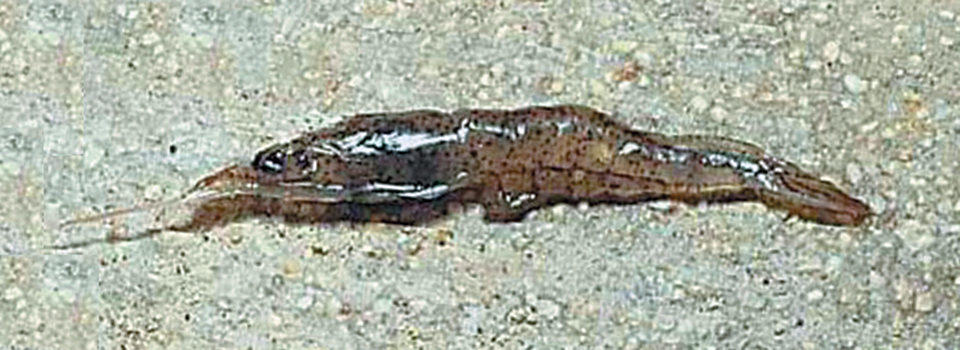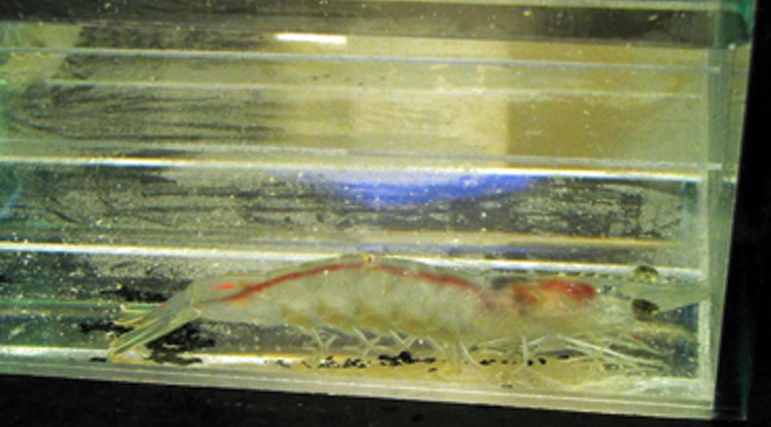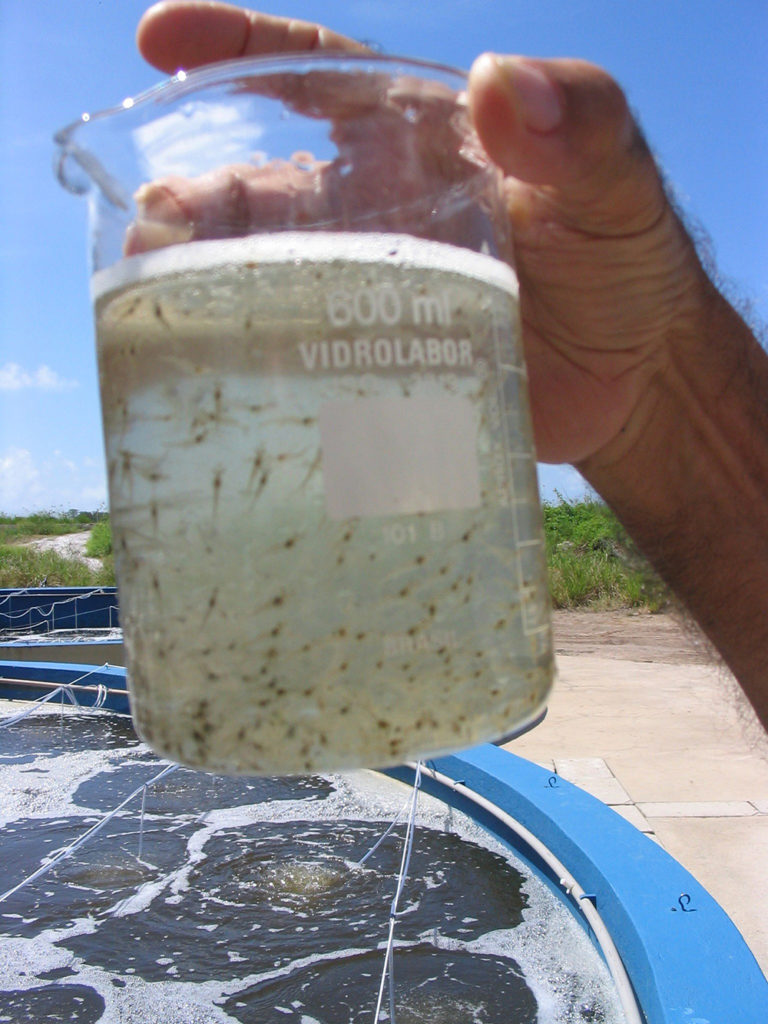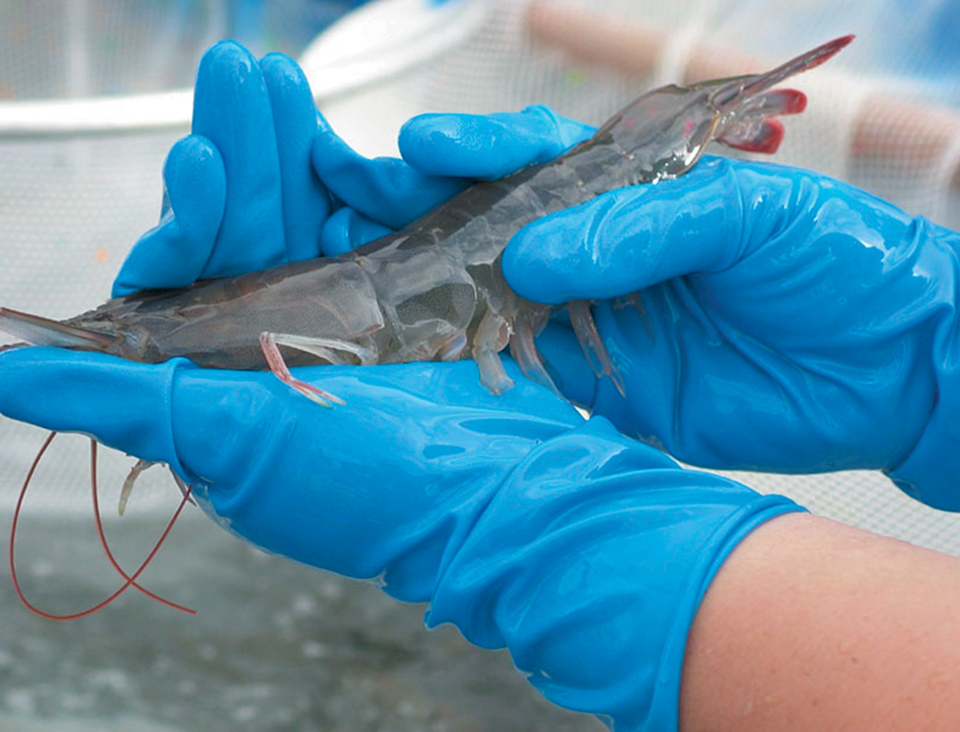Higher survival recorded at 32 degrees-C

Since the early 1990s, Taura Syndrome Virus (TSV) type A has been responsible for substantial crop losses at shrimp farms in the Americas and, more recently, Asia. From 1992 to 1997, the economic impact from TSV was estimated to approach U.S. $1.4 billion.
Because there are no therapeutic treatments available for TSV disease, shrimp producers have developed other management strategies to reduce mortality from TSV. Strategies that have been used with varying success include stocking with genetic lines of Litopenaeus vannamei that are less sensitive to the virus; stocking with species less sensitive to TSV, such as L. stylirostris; and stocking L. vannamei at a high initial density with the anticipation of an adequate count at final harvest.
In 2000, the CENIACUA group in Colombia discovered that juvenile L. vannamei held at a water temperature of 32 degrees-C not only survived exposure to lethal concentrations of White Spot Syndrome Virus, but also tested negative by polymerase chain reaction (PCR) for the virus. The authors surmised that hyperthermic conditions might also protect shrimp from mortality due to TSV.
TSV exposure trials
From July 2001 to January 2003, the authors ran a series of three trials to test the effects of increased water temperature on the survival of juvenile shrimp challenged with TSV, type A. A fourth trial tested the effects of elevated temperature on the infectivity of TSV. The United States Department of Agriculture; Center for Tropical and Subtropical Aquaculture; and Hawaii Department of Agriculture, Aquaculture Development Program, provided funding for the research.
In the three oral exposure trials, L. vannamei that averaged 2 grams in size were collected from an isolated farmed population on the North Shore of Oahu, Hawaii, USA. Known to be sensitive to TSV, the shrimp were stocked at 10 shrimp per 57-liter aquarium. For each trial, the shrimp were divided into four groups, each with two replicate aquariums:
- TSV-exposed group held in water at 32 degrees-C
- TSV-exposed group held in water at 27 degrees-C
- Control group held in water at 32 degrees-C
- Control group held in water at 27 degrees-C.
Temperature was measured once each day with a hand-held thermometer. The temperature in the heated aquariums was maintained with immersion heaters. The 27 degrees-C tanks required no special efforts to keep them at a stable room temperature. Water in these aquariums was filtered and kept at a salinity of 11 to 12 ppt.
During the three trials, the TSV-exposed shrimp were fed approximately 1 gram of TSV-positive tissue for the first two days and a commercial pelleted shrimp feed for 15 days. The shrimp in the control groups were fed only pelleted shrimp feed during the trials.
Dead and moribund shrimp were collected twice a day. At the end of trial 1, shrimp were sampled and preserved for histology examination only. In trials 2 and 3, shrimp were sampled and preserved for histology and PCR assay for TSV. For PCR assay, shrimp tissues were pooled at 3 to 10 shrimp per vial.
Inactivation trial
Trial 4 explored the possibility that heat exposure at 32 degrees C would by itself inactivate TSV. For this study, 2-gram juvenile shrimp were divided into three treatment groups:
- Shrimp injected with a cell-free tissue extract, unheated TSV inoculum.
- Shrimp injected with the same TSV inoculum as group 1, except the inoculum was heated to 32 degrees-C for one hour and cooled to room temperature prior to injection.
- Control shrimp injected with standard TN buffer diluted 1:10 in 2 percent saline.
Each shrimp was injected intramus-cularly into the third abdominal segment with 0.1 ml inoculum. The shrimp were monitored for 15 days, during which they received commercial pelleted feed. Daily tank temperatures were recorded, and tissue samples were collected and preserved from all moribund and dead shrimp. At the end of the trial, all remaining shrimp were sacrificed, and tissues were collected for PCR assay.
The assays were carried out by the staff of the Aquaculture Pathology Group at the University of Arizona. Survival results compared the various treatment and control groups with a standard T-test, a statistics test used to compare the means of two samples.
Results
The mean survival results for trials 1-3 are summarized in Table 1. The findings indicated that holding the TSV-exposed shrimp in heated water significantly (P < 0.01) resulted in 80 percent survival, compared to 20 percent survival in the nonheated control tanks.
Montgomery-Brock, Mean survival of juvenile L. vannamei in trials 1, 2, and 3, Table 1
| Treatment Group (trials 1, 2, 3) | Survival (% range |
|---|---|
| Nonheated, TSV-exposed | 20.0a (0-40) |
| Heated, TSV-exposed | 80.0b (70-90) |
| Nonheated control | 90.0b (80-100) |
| Heated control | 70.0b (50-90) |
PCR assays of pooled tissue samples from shrimp in the nonheated groups were positive for TSV in trials 2 and 3. Although not explained, samples from the heat treatment groups were negative for TSV in trials 2 and 3.
The survival results for trial 4 are summarized in Table 2. Study findings indicated that brief heat treatment did not inactivate the infectivity of TSV-exposed tissue.
Montgomery-Brock, Survival of juvenile L. vannamei in a heated inoculum study (trial 4), Table 2
| Treatment Group (trial 4) | Survival (% range) | PCR Results |
|---|---|---|
| Nonheated inoculum | 10a (0-20) | Positive |
| Heated inoculum | 15a (10-20) | Positive |
| Control | 95b (90-100) | Negative |
Conclusion
Trials consistently showed higher survival of TSV-challenged shrimp held in water heated to 32 degrees-C. These findings were similar to those from heat-treatment studies conducted with WSSV. They suggested that the benefits of heat treatment found for WSSV, a DNA virus, extend to TSV, an RNA virus, and they diseases may have a similar, common mechanism in shrimp. Heat treatment to 32 degrees-C alone did not appear to inactivate TSV. Further studies are in progress to examine the effect of heat on TSV.
(Editor’s Note: This article was originally published in the August 2003 print edition of the Global Aquaculture Advocate.)
Now that you've reached the end of the article ...
… please consider supporting GSA’s mission to advance responsible seafood practices through education, advocacy and third-party assurances. The Advocate aims to document the evolution of responsible seafood practices and share the expansive knowledge of our vast network of contributors.
By becoming a Global Seafood Alliance member, you’re ensuring that all of the pre-competitive work we do through member benefits, resources and events can continue. Individual membership costs just $50 a year.
Not a GSA member? Join us.
Authors
-
Dee Montgomery-Brock
Center for Tropical, Subtropical Aquaculture
State of Hawaii Department of Agriculture
Aquaculture Development Program
Anuenue Fisheries Research Center
1039 Sand Island Parkway
Honolulu, Hawaii 96819 USA[109,111,99,46,114,114,46,105,105,97,119,97,104,64,50,48,48,107,99,111,114,98]
-
Ron Y. Shimojo, M.S.
Center for Tropical, Subtropical Aquaculture
State of Hawaii Department of Agriculture
Aquaculture Development Program
Anuenue Fisheries Research Center
1039 Sand Island Parkway
Honolulu, Hawaii 96819 USA -
Kimber Cochrane
Center for Tropical, Subtropical Aquaculture
State of Hawaii Department of Agriculture
Aquaculture Development Program
Anuenue Fisheries Research Center
1039 Sand Island Parkway
Honolulu, Hawaii 96819 USA
Related Posts

Health & Welfare
Colombian shrimp research associates TSV, NHP selection, resistance
In an NHP (necrotizing hepatopancreatitis) challenge test, shrimp from a Colombian breeding program had higher resistance and 30 percent greater survival than a control line of Taura syndrome virus-free shrimp.

Health & Welfare
A study of Zoea-2 Syndrome in hatcheries in India, part 1
Indian shrimp hatcheries have experienced larval mortality in the zoea-2 stage, with molt deterioration and resulting in heavy mortality. Authors investigated the problem holistically.

Health & Welfare
A study of Zoea-2 Syndrome in hatcheries in India, part 2
Indian shrimp hatcheries have experienced larval mortality in the zoea-2 stage, with molt deterioration and resulting in heavy mortality. Authors considered biotic and abiotic factors. Part 2 describes results of their study.

Health & Welfare
Biosecurity principles for sustainable production using SPF shrimp
Basic components of biosecurity include knowledge of diseases, adequate detection methods and the use of “clean” shrimp stocks.


